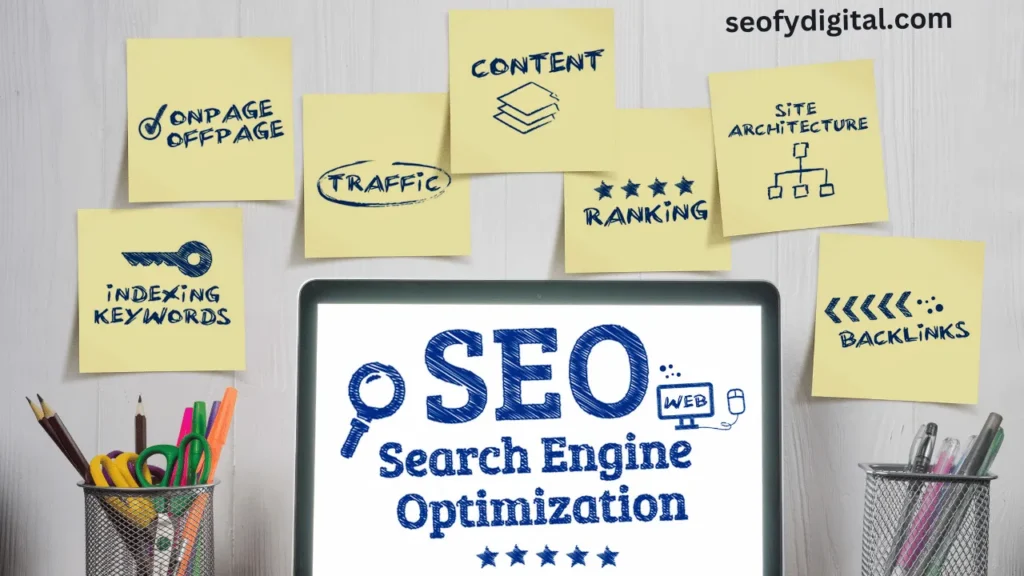Imagine you run a small business selling handmade candles online. You’ve poured your heart into creating unique scents and beautiful packaging. Yet, despite having a stunning website, customers are not finding you.
This is where Search Engine Optimization (SEO) comes into play. SEO is a crucial strategy that helps your website become visible to potential customers through search engines like Google. In a world where over 90% of online experiences start with a search engine, mastering SEO is not just an option; it’s a necessity for success.
SEO is more than just a buzzword; it’s the art and science of enhancing your online presence to attract organic traffic. This means visitors come to your site without paid advertisements. The importance of SEO cannot be overstated.
It not only increases your website’s visibility but also builds trust with your audience, improves user experience, and ultimately boosts conversions. In this blog post, we will explore the foundational aspects of SEO, practical applications, and how to measure your success. Let’s embark on this journey to unlock the power of SEO for your online presence!

Contents
- 1 1. Understanding the Basics of SEO
- 2 Why is SEO Important?
- 3 Types of SEO
- 4 2. The Practical Application of SEO
- 5 Keyword Research
- 6 Content Creation
- 7 Backlink Building
- 8 Technical SEO
- 9 3. Measuring SEO Success
- 10 Using Analytics Tools
- 11 Interpreting Data and Making Data-Driven Decisions
- 12 Conclusion
- 13 Recap of Key Points
- 14 Future Trends in SEO
- 15 Final Thoughts
- 16 FAQs
1. Understanding the Basics of SEO
What is SEO?
At its core, Search Engine Optimization (SEO) refers to the strategies and techniques used to improve a website’s visibility in search engine results. When you search for something on Google, it uses complex algorithms to determine which websites to display and in what order. Here’s how it works:
- Crawling: Search engines use bots to crawl websites and gather information.
- Indexing: The information collected is organized and stored in a database.
- Ranking: Search engines rank websites based on their relevance to specific search queries.
Why is SEO Important?
SEO is vital for several reasons:
- Increased Organic Traffic: Higher visibility in search results leads to more visitors. For example, a blog that ranks on the first page of Google for “best homemade candle recipes” can attract thousands of visitors per month.
- Improved Brand Awareness and Credibility: When your website appears at the top of search results, it conveys authority and trust. Users are more likely to click on results from reputable sources.
- Higher Conversion Rates: SEO optimizes your website for the right audience. If your site ranks high for “eco-friendly candles,” it’s more likely to attract customers interested in your products, resulting in increased sales.
- Enhanced User Experience: SEO is not just about search engines; it also focuses on providing a better experience for visitors. A well-structured website with quality content keeps users engaged and encourages them to return.
Types of SEO
SEO can be categorized into three main types:
- On-page SEO: Involves optimizing individual web pages to rank higher and earn more relevant traffic. This includes:
- Keyword Research and Optimization: Finding and using relevant keywords in your content. For instance, if you’re selling candles, keywords could include “handmade candles,” “scented candles,” or “natural wax candles.”
- High-Quality Content Creation: Creating informative and engaging content that provides value to your audience. A blog post on “How to Choose the Perfect Candle for Your Home” could attract visitors.
- Meta Tags and Descriptions: Crafting compelling titles and meta descriptions that include keywords. For example, a meta description for your candle page could be “Shop our collection of eco-friendly handmade candles, perfect for any occasion.”
- Header Tags (H1, H2, etc.): Organizing content with headers to make it easily readable and scannable for both users and search engines.
- Image Optimization: Using descriptive file names and alt text for images. For example, naming an image “lavender-scented-candle.jpg” helps search engines understand the content.
- URL Structure: Creating user-friendly URLs that reflect the page content. A URL like www.yourwebsite.com/handmade-candles is better than www.yourwebsite.com/page123.
- Keyword Research and Optimization: Finding and using relevant keywords in your content. For instance, if you’re selling candles, keywords could include “handmade candles,” “scented candles,” or “natural wax candles.”
- Off-page SEO: Focuses on increasing your site’s authority through external factors, including:
- Backlink Building Strategies: Getting other reputable websites to link back to yours. For instance, if a popular home decor blog features your candles, it can drive traffic and improve your site’s authority.
- Social Media Marketing: Engaging with your audience on social platforms to drive traffic to your website. Sharing posts about your candle-making process can attract interest.
- Local SEO: Optimizing for local search results, especially important for businesses with physical locations. For example, ensuring your business appears on Google Maps for searches like “candles near me.”
- Backlink Building Strategies: Getting other reputable websites to link back to yours. For instance, if a popular home decor blog features your candles, it can drive traffic and improve your site’s authority.
- Technical SEO: Focuses on improving the backend structure and foundation of a website. This includes:
- Website Speed Optimization: Ensuring your site loads quickly, as slow-loading pages can deter visitors. A website speed of under three seconds is ideal.
- Mobile-Friendliness: Ensuring your website is responsive and functions well on mobile devices. Google prioritizes mobile-friendly sites in its rankings.
- XML Sitemaps: Creating an XML sitemap helps search engines understand your website structure and find new pages.
- Robots.txt: A file that tells search engines which pages they should or shouldn’t crawl.
- Website Speed Optimization: Ensuring your site loads quickly, as slow-loading pages can deter visitors. A website speed of under three seconds is ideal.

2. The Practical Application of SEO
Keyword Research
Keyword research is the cornerstone of effective SEO. It involves identifying and analyzing the search terms your target audience uses. Here’s how to conduct keyword research effectively:
- Identifying Relevant Keywords: Start by brainstorming topics related to your business. Use tools like Google Keyword Planner or Ubersuggest to find keywords that have a good search volume and lower competition.
- Using Keyword Research Tools: Tools like Ahrefs and SEMrush provide insights into keyword performance, helping you choose the best keywords to target.
- Keyword Placement and Density: Integrate keywords naturally into your content. Aim for a keyword density of around 1-2%, meaning your keyword should appear in about 1-2% of the total word count.
Content Creation
Creating high-quality content is vital for SEO. Here are some key aspects:
- Creating Valuable, Informative Content: Focus on topics that interest your audience. For example, a guide on “How to Care for Your Candles” can attract potential buyers.
- Content Optimization for Search Engines: Use your targeted keywords in the first 100 words of your content and throughout the text to signal relevance to search engines.
- Content Marketing Strategies: Promote your content through social media, email newsletters, and collaborations with influencers to reach a broader audience.
Backlink Building
Backlinks are critical for improving your website’s authority. Here’s how to build effective backlinks:
- The Importance of Backlinks: Backlinks from reputable sites signal to search engines that your content is trustworthy and valuable.
- Effective Backlink Building Techniques: Guest posting on popular blogs in your niche can earn you backlinks. For instance, writing an article on “Sustainable Candle Making” for a green living blog can direct traffic back to your site.
- Link Building Best Practices: Focus on quality over quantity. A single backlink from a well-known site can be more valuable than multiple links from lesser-known sites.
Technical SEO
Technical SEO ensures that search engines can crawl and index your website efficiently. Key elements include:
- Website Speed Optimization Tips: Use tools like Google PageSpeed Insights to analyze your site’s speed and implement suggestions, such as image compression and leveraging browser caching.
- Mobile-Friendly Design and Optimization: Test your site using Google’s Mobile-Friendly Test tool to ensure it provides a seamless experience on mobile devices.
- XML Sitemap and Robots.txt Configuration: Regularly update your XML sitemap to reflect new content and configure your robots.txt file to guide search engines on which pages to crawl.
- Secure Website (HTTPS): Ensure your website uses HTTPS, which encrypts data and provides a secure browsing experience. Google favors secure sites in its rankings.
3. Measuring SEO Success
Key Performance Indicators (KPIs)
To assess the effectiveness of your SEO efforts, monitor these KPIs:
- Organic Traffic: Track the number of visitors coming from search engines. Tools like Google Analytics can help you monitor this data over time.
- Keyword Rankings: Use tools like SEMrush or Ahrefs to track how well your target keywords rank on search engine results pages.
- Backlinks: Monitor the number and quality of backlinks to your site, as these are crucial for building authority.
- Domain Authority: Use Moz’s Domain Authority metric to evaluate your site’s strength compared to competitors.
- Conversion Rates: Analyze how many visitors complete desired actions on your site, such as making a purchase or signing up for a newsletter.
Using Analytics Tools
Utilizing analytics tools is essential for tracking your SEO progress:
- Google Analytics: This free tool provides insights into traffic sources, user behavior, and conversion rates, helping you identify areas for improvement.
- Google Search Console: Monitor your site’s performance in Google search results, identify indexing issues, and analyze keyword rankings.
- Other Analytics Tools: Tools like Ahrefs and SEMrush offer additional features for in-depth analysis of backlinks, keyword rankings, and competitive insights.
Interpreting Data and Making Data-Driven Decisions
The key to successful SEO is using data to inform your decisions:
- Identify What Works: Analyze which keywords and content types drive the most traffic and conversions. Adjust your strategy based on these insights.
- Adjusting Strategies: If certain keywords aren’t performing, consider tweaking your content or targeting different keywords based on trends and audience interests.
- Ongoing Optimization: SEO is an ongoing process. Regularly review your data, update your content, and refine your strategies to stay competitive.
Conclusion
In conclusion, Search Engine Optimization (SEO) is an indispensable tool for any business looking to thrive online. By understanding its fundamentals, implementing effective strategies, and measuring success, you can significantly improve your website’s visibility and drive valuable traffic.
Recap of Key Points
We discussed the basics of SEO, its importance, and various types including on-page, off-page, and technical SEO. We also covered practical applications such as keyword research, content creation, backlink building, and the significance of analytics in measuring success.
Future Trends in SEO
As we look to the future, emerging trends such as voice search, AI-driven search algorithms, and a focus on Core Web Vitals will shape the SEO landscape. Ethical SEO practices, including transparency and user privacy, will also gain prominence.
Final Thoughts
SEO is a powerful strategy that can transform your online presence. As you implement these strategies, remember that patience and consistency are key. The digital landscape is constantly evolving, so stay informed and adapt to changes. For further learning, consider exploring resources like Moz, HubSpot, and Google’s SEO Starter Guide.
FAQs
1. What is SEO, and how does it work?
SEO, or Search Engine Optimization, is a set of practices aimed at improving the visibility and ranking of a website in search engine results. It involves optimizing content, building backlinks, and enhancing technical aspects to attract organic traffic.
2. Why is SEO important for my business?
SEO is essential for increasing organic traffic, building brand awareness, improving credibility, and enhancing user experience, leading to higher conversion rates and sales.
3. What are the key components of on-page SEO?
On-page SEO includes keyword research and optimization, high-quality content creation, meta tags, header tags, image optimization, and user-friendly URL structure.
4. How can I conduct effective keyword research?
You can conduct keyword research by brainstorming relevant topics, using tools like Google Keyword Planner, and analyzing search volume and competition to identify valuable keywords.
5. What is the significance of backlinks in SEO?
Backlinks from reputable websites signal to search engines that your content is trustworthy and relevant, improving your site’s authority and ranking in search results.
6. How can I measure my SEO success?
You can measure SEO success by tracking key performance indicators (KPIs) such as organic traffic, keyword rankings, backlinks, domain authority, and conversion rates using tools like Google Analytics and Google Search Console.








